Content [show]

Houseplants make our homes cozy and always pleasing to the eye. However, not every homeowner has the patience to tinker with the land, tending to green "decorations".
We are in found out that there are plants that can easily do without land. And here is a list of them.
Garlic
When placed in water, the garlic cloves will produce edible shoots that can be added to salads.
More ideas for reusing food leftovers can be found here.
Chinese cabbage
A new fork can be grown from the underside of used Peking cabbage alone. To do this, you just need to place the segment in a small amount of water.
You can read more about growing this vegetable in the kitchen in this article.
Green onions
A glass, water, and a few stalks of green onions are all it takes for a permanent green supply.
And here you can read the tips with which your harvest will be healthy and rich.
Carrot
Carrot tops quickly develop new green curls when the vegetable cuttings are placed in a container of water. These greens are edible and can be added to salads or eaten mixed with honey.
Learn more about growing carrot tops in water here.
Leek
For growing leeks at home, its stems are cut to a length of 5 cm and placed in a container with water.
Read more about this method here.
Mint
Mint can be used to make teas, sweets, and some sauces. And growing it is very simple: it is enough to immerse the roots of the plant in water.
Basil
It is not at all necessary to go to the market for these fragrant herbs. It is quite possible to grow basil in a glass of water.
Read more about this method here.
Rosemary
In order to grow rosemary in your kitchen, you need put a few stems of the plant in the water and wait until the roots appear.
Rosemary can stay in this position for quite a long time, but when the roots grow, you still have to transplant it into the ground.
Tulips
Many people think that tulips can only be grown in gardens. However, they can bloom at home.
For this, the flower bulbs must be placed in a vase with a little water. Read more about growing tulips in water here.
Eichornia

This plant also feels great without land. Eichornia is not only unassuming to the conditions of detention, but also tenderly beautiful.
You can read more about the containers in which it can be contained in this post.
Hyacinth
These beautiful flowers can also be grown at home on a windowsill. To do this, hyacinths are placed in a vase filled with decorative stones and a little water.
When growing hyacinths, it is important to keep an eye on the lighting. You can see how to set it up here.
Amaryllis
Another beautiful bulbous plant that can bloom without soil. To do this, you need a vase, a fixative (for example, pebbles) and water.
Read more about the content of amaryllis in this article.
Cyperus
This plant, which looks like a thin fragile palm, does well without planting. The main condition for its growth is water.
The easiest way to grow cyperus is in non-drying pots. Read more about how it grows here.
Indoor reed
The same plant is called drooping reeds and cuckoo tears. It grows well in water and looks best in tall vases.
This reed is considered one of the most beautiful indoor aquatic plants and from a distance looks like it is made of fiber optic. Detailed "characteristics" can be studied here.
Bamboo
Bamboo grows quickly and easily takes the desired shape. There are several types of bamboo that are suitable for keeping in a room.
For the full development of this plant, a vase of water is enough. Read more about how to decorate the interior with bamboo and other unpretentious plants in this article.
Epipremnum golden
This plant is often planted in pots with soil. But at the same time, it feels great in water.
Looks epipremnum uncomplicated, but does not require special care. In addition, they can be great to decorate the walls of the room. Find inspiration here.
Aglaonema
Aglaonema is not an aquatic plant and its ideal environment is soil pots. However, if you do not expect rapid growth from him, you can keep the flower in water.
In a vase, the stems will slowly grow and please the eye. You can read more about Aglaonema in this article.
Succulents (including cacti)
These plants are very popular as they do not require frequent watering or full pots. Ideas on which container to root your succulent in can be found here.
And in order to forget about transplanting and moisturizing these plants for a long time, you can use the method of conventional hydroponics. To do this, a pot of cactus is filled with clay pebbles and placed in a second pot filled with water.
Tillandsia
And this exotic plant not only can easily do without land, but can live without water. You can find a lot of ideas on how to decorate the interior with this flower here.
Only humidified air is enough for tillandsia to grow. But for better development, it is advisable to pamper its leaves and roots with cool water baths once a week.
Photo credit Depositphotos
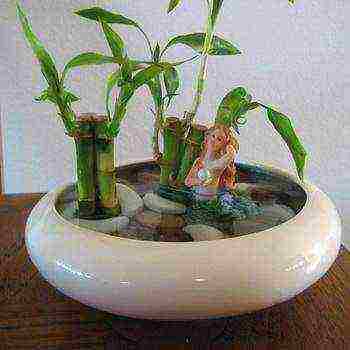 Currently, the phytodesign of the interior of houses and apartments is becoming more and more diverse. One of the latest trends in phytodesign is the arrangement of water gardens and indoor ponds. Growing indoor plants and flowers in water creates favorable conditions due to the optimal level of air humidity.
Currently, the phytodesign of the interior of houses and apartments is becoming more and more diverse. One of the latest trends in phytodesign is the arrangement of water gardens and indoor ponds. Growing indoor plants and flowers in water creates favorable conditions due to the optimal level of air humidity.
In recent years, a number of simple tabletop fountains and waterfalls have appeared - they have the sound of flowing water, but there are no plants.
For some reason, water devices and plants in rooms are rarely put together. This cannot be attributed to a lack of interest in aquatic gardening, as it is one of the fastest growing areas in outdoor gardening. This is hardly due to the price - an indoor waterfall costs less than a dinner for two. And of course, the reason cannot be a lack of advantages - the water device helps the plants by increasing the humidity, and it looks impressive and original enough to impress your friends.
The main reason, apparently, is that, unlike garden ponds, indoor ones were denied the magic of television exposure and there is practically no information about them in magazines. Some people think that growing aquatic plants indoors is not practical.
Water garden and a flower in the water in the photo
You can equip a water garden, which will be located next to the reservoir. Semi-aquatic compositions use conventional rather than aquatic houseplants and are grown in pots or containers around the aquatic device. It is possible to incorporate a water device into an indoor garden, but a simpler approach is to create a potted group around it.First you need to purchase a water device, preferably with moving water - a small fountain, a domed bubble fountain, a stone with a waterfall, etc. Place it on a hard surface and set up a light source that illuminates the moving water.
Look at the photo of a flower in water - this is a great illustration of the original idea:

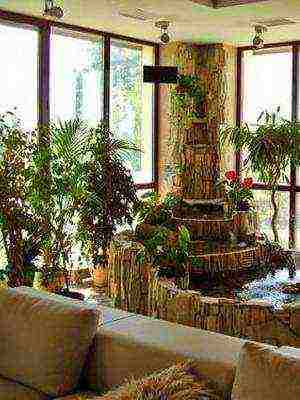

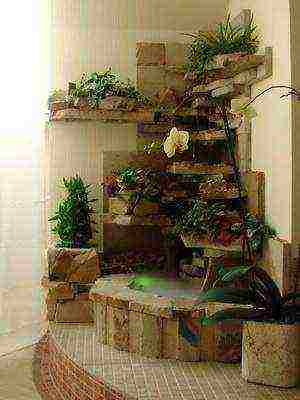
Now place potted plants around the water device. The tallest plants should be at the back of the composition. Medium-sized plants should be planted on the sides to surround the water area. An effective addition will be a weeping plant that does not interfere with a fountain or waterfall. Stunted and ampelous plants can be used in the front to hide the edges of the water container.
Compositions of indoor flowers in water
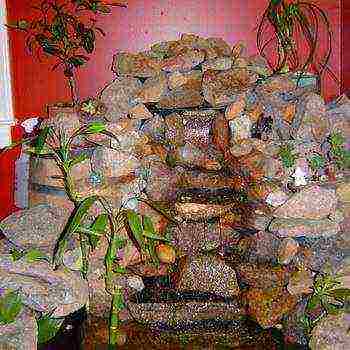 In this flower-in-water composition, one or more aquatic plants are grown in water. There may be common houseplants nearby, but this is not necessary. Simply put, it is an indoor pond device. Most experts believe that it is not practical to grow indoor flowers in water in your home. This was not always the case - the living room water gardens were in many Victorian homes, and for some people it was the flowers in the water, not the fish, that were the main attraction.
In this flower-in-water composition, one or more aquatic plants are grown in water. There may be common houseplants nearby, but this is not necessary. Simply put, it is an indoor pond device. Most experts believe that it is not practical to grow indoor flowers in water in your home. This was not always the case - the living room water gardens were in many Victorian homes, and for some people it was the flowers in the water, not the fish, that were the main attraction.
Critics are right when they point out flaws. Good lighting is absolutely essential. A winter garden with a glass roof is ideal, but you can also arrange a pond near a window on the south side. The ecological balance of the reservoir, which naturally keeps the water clean in the open air, does not occur indoors - the water area is too small, and the water temperature is higher than in the garden. Finally, if you want to grow water lilies, you will have to exclude fish and devices with moving water from the aquatic composition.
Despite the drawbacks, this indoor planting approach is worth trying. If you can't grow water lilies, you can find other attractive aquatic plants.
The first task is to select the most suitable type and size of water tank. There is a huge range from small glass bowls to large built-in basins. The most convenient and practical are a mini-pond with 80 liters of water for a sunny living room and a greenhouse pond for winter gardens and glazed rooms for plants.
How to make an indoor pond
Before making an indoor pond, you need to prepare a container: you can use any container that holds at least 25 liters of water. It should be decorative, waterproof, non-corrosive and non-toxic. The indoor pond should also be deep enough so that there is at least 15 cm of water above the top of the plant basket. An 80-liter one is best. Cover it with varnish on the outside and seal with a sealant such as bituminous paint on the inside. Place the container in the most well-lit area.
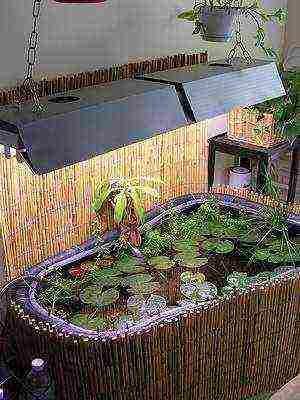

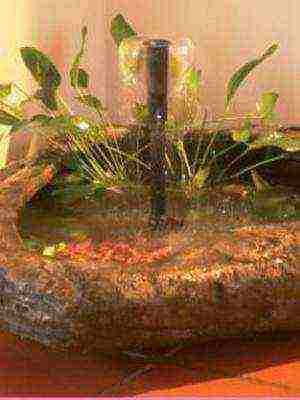
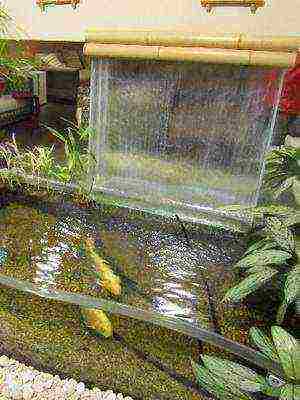
Pour in tap water and wait at least three days before starting planting. You will need a dwarf water lily and some floating plants, as well as oxygenators to help suppress algae growth. The surface of the water should be covered with leaves. Subsequently, when the leaves of the water lily begin to grow, some of the floating plants are removed.
Winter garden with a pond
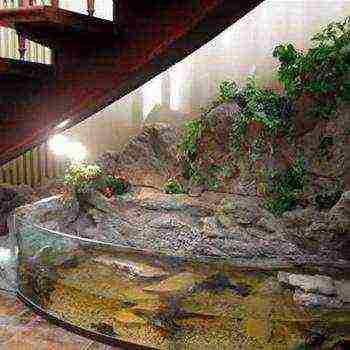 A conservatory with a pond can be a simple water lily design, as shown below, or an impressive device with a waterfall, lights, a variety of aquatic life inside, and a collection of indoor plants outside. Basic requirements are a solid base and a completely waterproof inner surface. The tank must be deep enough for the selected plants to be planted. If you plan to grow water lilies, you will have to refuse to breed fish and install a fountain or waterfall.
A conservatory with a pond can be a simple water lily design, as shown below, or an impressive device with a waterfall, lights, a variety of aquatic life inside, and a collection of indoor plants outside. Basic requirements are a solid base and a completely waterproof inner surface. The tank must be deep enough for the selected plants to be planted. If you plan to grow water lilies, you will have to refuse to breed fish and install a fountain or waterfall.
The easiest way is to buy a hard liner and cover the sides with wood paneling or veneer. Brick or stone will give the pond a more solid look. To improve their appearance, brick and block walls can be tiled. At this stage, you can install a filtration system that ensures the purity of the water.
Fill the reservoir with tap water and let it sit for three days before planting. The minimum required depth will depend on the plants you plan to grow. Aim for about two-thirds of the surface to be covered with water lilies and / or floating plants in order to inhibit the development of green algae. Pond cleaning by pumping water may be required every five years. While this work is in progress, store the plants in buckets of water.
If you are planning to install a fountain or waterfall, get an electrician. And remember that an active baby can drown with a water depth of only 10 cm.
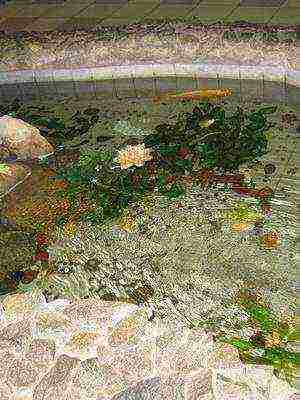
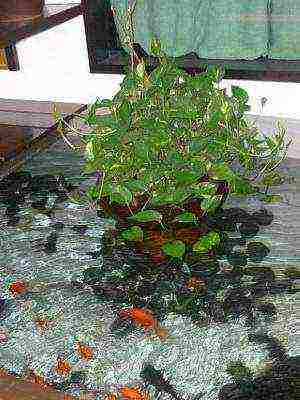
Rigid form. Use a fiberglass pond. If surrounding walls are to be built, choose a simple shape (square, rectangle, semicircle, etc.). For a thinner polyethylene pond, a wooden frame may be required for support. Usually black is chosen, but it depends on taste.
Flexible cover. Use butyl rubber wrap. For a pond, choose a simple shape. A thick wall is needed that can withstand the pressure of the mass of water. Make sure that the mortar has completely set before filling with water. After filling the edges and corners of the film, fold, fold over the edges and secure.
No lining material. You can do without an insert if a brick or block wall is made on a concrete base. The inside can be plastered with cement to improve its appearance. This is optional, but two coats of pond paint are required inside. Follow the instructions on its packaging.
Growing plants in water
To grow in water, you will need several types of aquatic plants that differ in their design. Water lilies in a pond for a winter garden are desirable, but not required - they require bright light and calm water. The main floral effect is provided by coastal plants, which, as a rule, are set at a shallower depth than dwarf water lilies. Both of these types of water are grown by composting in open baskets. Then you will need oxygenator plants. They are sold in bunches at the aquatic plant department.

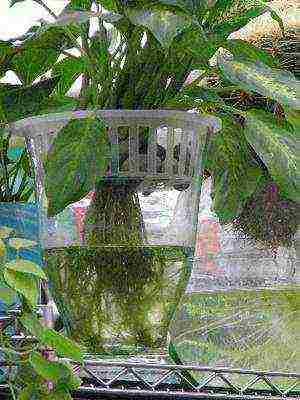
Place the bundle in a basket of heavy soil, cover with a layer of gravel and place on the bottom of the pool at the rate of one basket per square meter. Finally, floating plants are needed, which, together with water lilies, serve to cover the surface of the water. Their roots are submerged in water, but stems, leaves and flowers (if any) are above the surface. Just place them in water, and later, as they grow, remove some of the plants.
Did you know that you don't have to grow indoor plants in the ground? Basically, the earth acts as a mediator, supporting and guiding the plant upward and allowing the roots to absorb nutrients with moisture. You can throw away the soil, and with it all the insects and diseases! Many houseplants do well in a regular double pot with a simple aquatic attachment, sometimes called passive hydroponics. For hydrocultures, the stem and roots of the plant are held in place by special pebbles, not soil.
Steps
- Preparation - Place all materials in your kitchen sink, including:
-
Rinse the clay pebbles to remove dust and small particles of pebbles.
-
If the plant already has root cuttings, go to step 5.
-
Transplant from soil - Remove the plant from a pot of soil. Take the plant by the base near the soiled part and wiggle slightly, shaking off the dirt and everything else. Rub on the pot to clean the plant. Remove dirt from it.Shoot down loose lumps of dirt. Run it under a gentle stream of water at room temperature to rinse off any remaining dirt. Trim off dead roots or additional cuttings.
-
Plant a plant. Cover the bottom of the inner pot with pebbles at a height of about 2.5 cm. Place the plant on the pebbles and spread out the roots. Holding with one hand, pour the pebbles around the roots of the plant to the very base. Press down on the pebbles in a pot and then rinse under running water at room temperature.
-
Finish and feed the plant. Place the inner pot in the outer pot and fill it with nutrient solution until the water level indicator shows it is full enough.
-
Then put it in a room with a temperature of 18-23 degrees.
Tips
- Many plants thrive in hydrocultures, including cacti and succulents. Feel free to experiment.
- Liana is the easiest plant to grow and prune in water. Start by growing vines.
- It is easier to transplant a dry plant from the ground.
- Consider buying a pre-planted hydroculture plant as a model before making your first transplant.
- You can enjoy your indoor plant in hydroculture without ever digging in the mud. Buy a pre-seedling, or an aquatic plant already with root cuttings.
- It is allowed to touch the roots, but do it carefully.
- Plants that originally took root in water are more likely to thrive in hydroculture.
- You can choose a decorative outdoor pot instead of a simple pair, but it should be much larger than the indoor pot.
Warnings
- Do not add water to maintain full level. Plants look much better if the water level drops or falls below the fill level before gravy.
- Do not lose sight of the water level and try to measure it by eye. The trick of hydroculture is that, thanks to the water indicator, you won't be able to pour more water than is required.
- The nutrients are not particularly hazardous, but you should still store them in hard-to-reach places.
What do you need
- Water - Tap water will usually do.
- Nutrients - can be ordered along with liquid materials and then mixed with water.
- Plant - Many indoor plants adapt well to hydrocultures.
- Pebbles - Clay pebbles are used for hydrocultures, ranging from the size of a pea to a grape.
- Inner Pot - The pebbles will be poured into the inner pot with holes for access to water. The inner pot also has a hole for a water level indicator.
- The water level indicator is a simple float that will tell you when it is time to add water to the pot (lower level), and when there is enough liquid (upper level).
- Outer Pot - The inner pot fits into a decorative, non-porous pot that is slightly larger.
- Kit - The kit contains everything you need to get started.
Article Information
This page has been viewed 5102 times.
Was this helpful?
If you want to have live plants at home, but do not have the experience of a home grower or florist, start simple. Remember how in your childhood your grandmother grew green onions on the windowsill in the spring, simply by dipping a trimmed onion into a glass of water or a saucer, and try growing edible greens in water. You will surely like it and want to grow other plants in a jar of water. Meet those of them that grow quietly without soil, in water.
Start by growing green onions
Take a few rooted green onions and place them in a glass of water. Add fresh water regularly: if there is a smell, it means that the onion has pulled out all the necessary minerals from the water and you need fresh water. Take water at room temperature.Do not pinch off the feathers for the first week, let the plant grow stronger.
Leeks on the windowsill
Leave the leeks in 5cm stems and place the bulbs in the water. You need to take a strong healthy onion. When the bulb has good roots, little water can be poured, then it rots more slowly. You can add one activated charcoal tablet to the water to cleanse it.
Cut feathers no earlier than two weeks later.
If you want to grow many onion heads, you can successfully use an egg container, cut it into two parts, pour water into the bottom, cutting off the tops of the tubercles, put an inverted half on top and place in the cells of the onion.
Now try growing garlic
Simply place the garlic cloves in the water. Green shoots will appear, which can be added to ready-made meals. You will get a fragrant and healthy seasoning. There is no less vitamin C in the feathers of garlic than in the cloves. In addition, the greens contain carotene, which is not present in the cloves at all.
Disassemble the head of garlic into cloves, select the larger ones, mark them firmly in an upright position in a container of water. The water should cover half of the garlic cloves. The greens will appear in a week, and you can eat it in 3 weeks.
Do not throw away the leftover Chinese cabbage, grow a new fork out of it
Place the bottom of the Chinese cabbage that you would normally discard in the water. If you specifically buy cabbage so that you can sprout a new fork later, buy a cabbage with a thicker stump. Cut off its bottom a little. Place the container of water and cabbage in a cool place first. The cabbage will take root in a few days. You can pick off her leaves and eat them.
Forcing greens from carrots
When eating carrots, leave the tops with green curls and place them in water. Carrot greens with honey are delicious. You can add it to salads.
Mint
Just place a 6-8 cm sprig of mint in the water. In a week, she will start up roots. Mint leaves grow best at 20-25 degrees. In winter, place a container of water next to it, as mint doesn't like dry air. Use the mint leaves three weeks after the roots appear, when the branch reaches a height of 20 cm.
Basil
Basil is grown in water just like mint. Take 10 cm long basil sprigs, place them in a glass of water and place them on a sunny windowsill. In winter, basil needs additional lighting. Another feature is that he is afraid of drafts.
Rosemary
Rooting rosemary in water is no different from other greens. If you want to get more greenery, it is better to transplant the plant into the ground over time, since the plant has a branched root system. With good lighting, more essential oil is formed in rosemary, so it is advisable to place a jar of rosemary on a southern or eastern windowsill. The plant needs to be periodically sprayed with water. Cut the rosemary when the twigs are about 15 cm long.
Create a home florarium - a garden in a glass vessel
After you have grown onions and garlic at home, you can risk sprouting decorative bulbs in the water. But if you have a lot of experience in growing indoor flowers, and you have long been staring at a photo of flowers grown behind glass, without soil, you can create a whole florarium. Even beginners in indoor floriculture can create a florarium from cacti or other succulents. You will learn a lot from the following story about flowers that can be grown in water.
Start with tulips
Tulips can bloom without soil, just in a vase of water. Place the stones at the bottom of the vase. Place tulip bulbs on them with the roots facing down. Add a handful of pebbles to keep the bulbs from moving. Pour in so much water that the bulbs are 1-1.5 immersed in it.
Hyacinth
Hyacinths can be grown in a tall vase with pebbles and water.In winter, these flowers will delight you, but growing them from bulbs is not a quick matter. It will take 4-5 months before the flowers appear. First, take a vase with a narrow neck so that the bulb does not touch the water, and put the vase with water and hyacinth in the refrigerator, and when the sprout becomes 5 cm long, move it to a cold windowsill. Use large bulbs to ensure blooming.
Eichornia
This very delicate and beautiful flower is unpretentious. Under natural conditions, it purifies water and multiplies very quickly. Its second name is water hyacinth. Eichornia is not afraid of any pests. The plant blooms best at temperatures above 30 degrees, and when the temperature is below 22 degrees, flowering stops.
Another bulbous plant - amaryllis
Amaryllis is grown in water like other bulbous plants. Only roots should be in the water. Place the vase in a warm, sunny place. Roots appear quickly. Amaryllis blooms for 2-3 weeks.
Do you know what a cyperus looks like? Grow it in a vase
This herb from the sedge family grows well at home in the water, resembling a fragile palm tree. Tsiperus is useful for people with memory disorders, poor eyesight, it improves sleep and relieves headaches. But if a person is insecure or aggressive, he should not grow this plant at home.
Indoor reeds, or cuckoo tears
This plant is one of the most beautiful plants that can be grown in a container of water. Its filamentary leaves from afar seem to be an optical wire, and the plant itself resembles a fountain. This is a wetland plant that is accustomed to moisture, and you will be able to grow it at home in water.
Bamboo
It is said that bamboo brings wealth and happiness to the home. Growing it in water is easy. Place the vessel with bamboo on the western or eastern windowsill, while it is better if the plant is fenced off from the sun's rays by a curtain. If the air is dry, you can wipe the bamboo with a damp cloth. Water the bamboo daily with settled water, and change the water in the vessel once a week.
Ever green indoor liana Epipremnum golden
Epipremnum can be grown in a jar of water at room temperature all year round. Remember that the plant is poisonous, so it is best not to keep it indoors if you have small children. In indoor conditions, epipremnum does not bloom, but it has beautiful foliage.
Aglaonema
It is preferable to grow this plant in a pot of soil, but it can be grown in water. The plant is undemanding to care, roots appear in a week. Aglaonema can absorb a liter of water per day. On the other hand, they can survive for two weeks without additional watering. The plant can grow both in the sun and in the shade.
Anglaonema cleans the air from harmful impurities and bacteria. It is unlikely that this plant will bloom in water, and indeed at home, but it has beautiful foliage.
Have you ever grown succulents in water? Try it!
Fill the pot with water and place another pot in it, with stones on which the succulent is located: agave, saxifrage, jerky and others.
If the cactus has no root, you can cut the bottom off. Better to sharpen it like a pencil. Hold the cactus in a glass for a while so that it does not sink to the bottom. When the root is dry, mark the plant on a hillock of pebbles. Excess water can rot a cactus, so it should not touch it.
Growing plants at home in glass containers is beneficial if they are edible, and inedible plants attract with their beauty behind the glass. Any room will look prettier with a vase of stones and flowers. Even children can take care of such a mini-garden.


